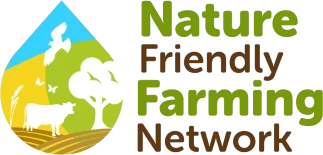From November to February, NFFN NI ran a series of farmer training courses delivered with Niels Corfield. Niels is a farm researcher and advisor who works to help create regenerative landscapes and farms across the UK, focusing on low-maintenance and productive systems. During his time in Northern Ireland, we focused on improving soil health, regenerative grazing management and whole farm planning and their role in supporting regenerative agriculture. Here are some of the key takeaways.
It all starts with soil
Building healthy soils is the foundation of regenerative land management, sustaining food production, improving carbon storage potential, increasing water holding capacity and supporting a vast array of underground life. We learned how strategies to improve soil health can significantly reduce costs by reducing the need for artificial inputs and sustaining high-quality output. The land is in “good heart”, and production benefits if soils are healthy.
The importance of management
Soil type is often one of the biggest barriers to achieving better business outcomes. In Northern Ireland, much of the land is dominated by heavy clay soils, which are prone to waterlogging, runoff and lower carrying capacities, which limit farming’s potential. Although soil type has an influence, Niels focused on the critical link between soil health and management. Using examples of the same soil type on the same farm under different types of management, he demonstrated how large an impact management has on infiltration rate, soil structure and overall function.
Observation informs action
The course emphasised the importance of regular observation to inform management practices and measure progress. Many of these can be done easily at a low cost and do not require sending soil samples to the lab for analysis. Simple testing techniques include spade testing to assess structure, infiltration tests to test water absorption rate and worm counts to determine biological activity. Regular monitoring is essential in developing soil improvement strategies but must be followed by action to see tangible improvements.
Soil health principles
Soil management is highly context-specific and based on the location and characteristics of each farming system. But applicable to all farms are seven fundamental principles which form the basis of improved soil health:
Maintain a living root to help transmit energy into the soil to help feed beneficial soil organisms and build aggregation.
Keep soil covered, if not by living roots, then by another form such as plant residues
Minimise disturbance through reduced cultivations and appropriate grazing regimes
Build diversity with a range of different plants
Feed the soil with organic materials to feed soil biology and increase soil organic matter
Incorporate animals into arable systems
Minimise the use of chemicals and synthetics
Making grazing amazing
Adopting regenerative grazing practices can have an incredible impact on building soil health and improving farm business resilience. Livestock can play a valuable role in nutrient cycling, adding organic matter to soils and building the vitality of grasslands. But crucially, management practices have the most significant impact, either as a force for good or bad. A key focus of this course was building the right grazing strategies to ensure that grasslands have sufficient rest periods between short bursts of intensive animal grazing. This can help produce healthier plants and healthier soils while reducing costs associated with housing animals in the winter, compared to set stocking that often results in under-resting of grassland systems.
This can be achieved through the more frequent movement of stock throughout the farm, allowing grasslands sufficient time to build stronger, healthier root systems. Starting regenerative grazing comes with some capital costs, but by adopting these techniques, soil health can be improved to support high production levels, extended grazing systems and reduced costs from fertiliser and housing bills.
Benefits of high-intensity grazing followed by more extended rest periods include deeper rooting plants, looser, more aggregated soils, larger, healthier plants, a deeper soil profile and dark soils rich in organic matter.
Grazing principles
Lengthen rest periods to allow full recovery before re-grazing
Maintain low and even utilisation rates for faster regrowth and lower worm-risk
Shorten grazing events to avoid overgrazing
Increase stocking densities to ensure evenness of utilisation
Increase trampling rates to break down thatch and feed soil organisms
Plan paddocks to ensure evenness of utilisation
Encourage pasture diversity through overseeding, bale grazing and silvopasture
Minimise and eliminate chemical wormers to drive pasture health and benefit dung beetles
Plan, trial, monitor, observe and record
Whole farm planning to future-proof your farm
The third part of the training focused on whole farm planning and the key practical principles to build farm resilience and productivity. This included practical examples of building resilience into the system through existing green infrastructure, such as hedgerows more effectively, integrating new green infrastructure into the system and investing in the right infrastructure to deliver management objectives. The course highlighted that a holistic, whole farm approach can provide tangible benefits for farm productivity, bring through new sources of revenue and deliver environmental gains. For example, incorporating productive trees into the system can provide forage and shelter for livestock while improving soil health and storing carbon. When carefully thought out, these can be embedded into the system to provide multiple benefits simultaneously rather than incurring unnecessary trade-offs.
An important feature of the course was using the natural character of the landholding to inform decision-making, from introducing regenerative grazing practices, investing in infrastructure and integrating trees and other green infrastructure
Moving forward
Farmers can achieve a pathway to regenerative farming by working from a trial scale to larger farm areas. The key lesson from these courses was to embed key principles into your system, taking account of your own context and business objectives while constantly monitoring and observing any changes over time. Given the rising costs of agrochemicals, the ongoing impacts of climate change and biodiversity loss on farm businesses, such strategies will become increasingly important. What struck us throughout the training was the genuine enthusiasm from farmers in the room, the experiences they’ve already had on this journey and their plans for the future moving forward. We hope this is just the start, and we plan to hold many similar events in the future.
Join NFFN as a free farmer member to be the first to hear of upcoming events and get exclusive first access before sharing publicly.


